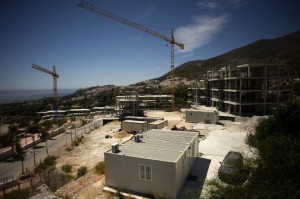Spanish banks saddled with repossessed properties

General view taken on August 30, 2012, shows unfinished apartment buildings in Benalmadena. Despite slashing prices by up to 60 percent, Spanish savings bank Cajamar has sold only half of the flats at a luxury block it owns on Spain’s Costa del Sol. AFP PHOTO/JORGE GUERRERO
BENALMADENA, Spain—Despite slashing prices by up to 60 percent, Spanish savings bank Cajamar has sold only half of the flats at a luxury block it owns on Spain’s Costa del Sol.
Last year, the bank ended up in possession of the “Mirador de Benalmadena” apartment building near Malaga, which has just over 100 flats, in settlement of debt by a property developer.
“Now that we own it, prices are down a great deal over what the developer wanted,” said Joaquin Luque, who manages the bank’s properties, as he walked by a huge empty pool surrounded by lush gardens and sea views.
A two-bedroom apartment that used to cost 400,000 euros ($500,000) is now available for 250,000 euros, he said.
“If a visitor arrives and makes an offer, we study it,” said Luque as he clutched a batch of keys to unsold apartments in his hand.
Article continues after this advertisementCajamar, like the majority of Spanish banks, has been saddled with a huge stock of repossessed real estate, including land and half-built residential properties, since a property bubble collapsed in 2008.
Article continues after this advertisementMost of the property is connected to developers who have been unable to repay their loans.
With banks under pressure to clean up their balance sheets and real estate prices still sliding, lenders have launched aggressive sales campaigns for their repossessed properties.
BBVA, Spain’s second-biggest bank, wants to sell all of the property on its hands within 18-21 months. It has 8.7 billion euros ($10.9 billion) of real estate on its books.
The country’s biggest lender, Santander, has said its “toxic assets will be ‘water under the bridge’ by 2013.”
Bank branches across Spain prominently display colorful brochures offering flats at rock-bottom prices.
“A house by the sea from just 36,700 euros,” reads a brochure put out by Soria, the real estate arm of Banco Sabadell.
“Discounts of up to 70 percent until September 30,” says another advert.
With Spain suffering a near 25-percent unemployment rate and credit scarce, banks are looking to offload their real estate to foreign buyers, especially properties located in tourist resorts.
One-third of the 676,000 new homes up for sale in Spain are on the coast, said Jose Manuel Galindo, the president of the Spanish Property Developers Association, which is working with the government to promote Spanish real estate abroad.
“You have to identify the most active markets. We are thinking of European Union members and also emerging countries. Russia for example is a very active market, and other markets like China,” he said.
“We are working with the foreign ministry to simplify the bureaucracy involved in buying a home in Spain,” he added.
The association wants the government to ease rules for entry visas and the transfer of capital to Spain to pay for a property.
Some banks are getting into the role of property developers, building properties on land they received to settle debts.
“There are banks which have land that no one will buy now,” said Fernando Encinar, the head of the research department at real estate website Idealista.
“And if they are in well-located cities, where they know that if they build affordable houses they will be able to sell them, so they are building.”
Construction of new homes though is far from the level it was at the height of Spain’s credit-fueled property boom.
A total of 76,005 new homes were built in Spain last year, down from 737,186 in 2006.
Building more homes in a country that has over one million still unsold is justified because “there are areas where there still exists demand if the price is reasonable,” said Encinar.
“There are other areas where no one wants to buy and where new homes will not be built for a long time,” he added.
While in the hills overlooking Benalmadena large cranes are building a new apartment complex overlooking the sea, just 30 kilometers (18 miles) away in Malaga an unfinished apartment block belonging to Cajasur is covered in graffiti.
“Maybe one day we will see the demolition of an unfinished property development and the land will be allowed to return to nature,” said Encinar.